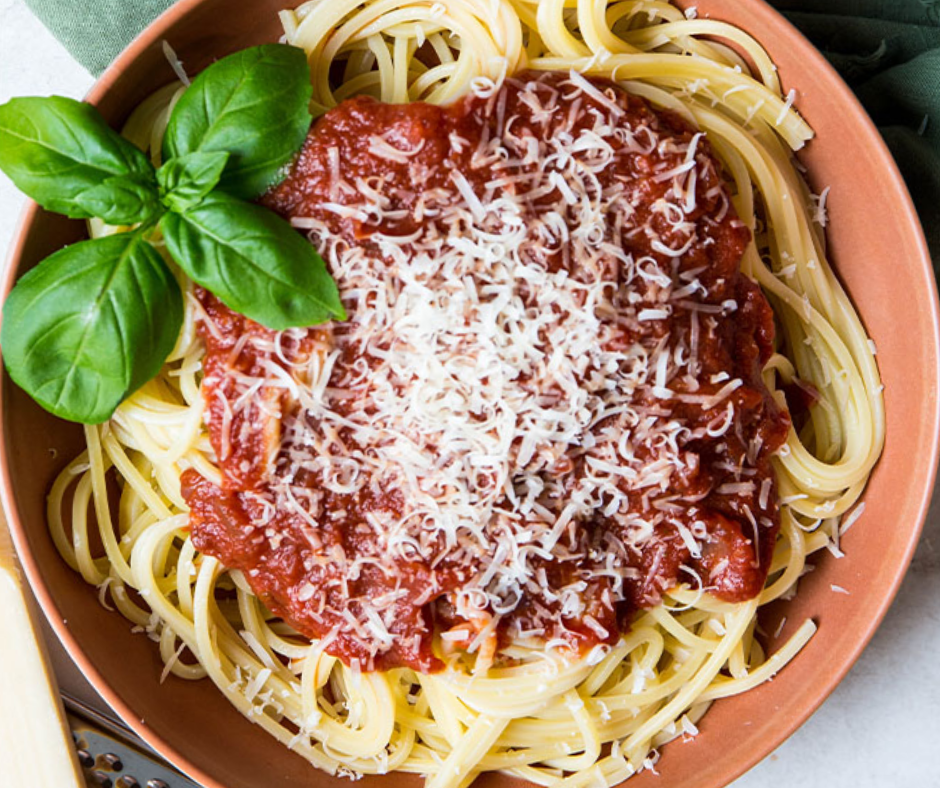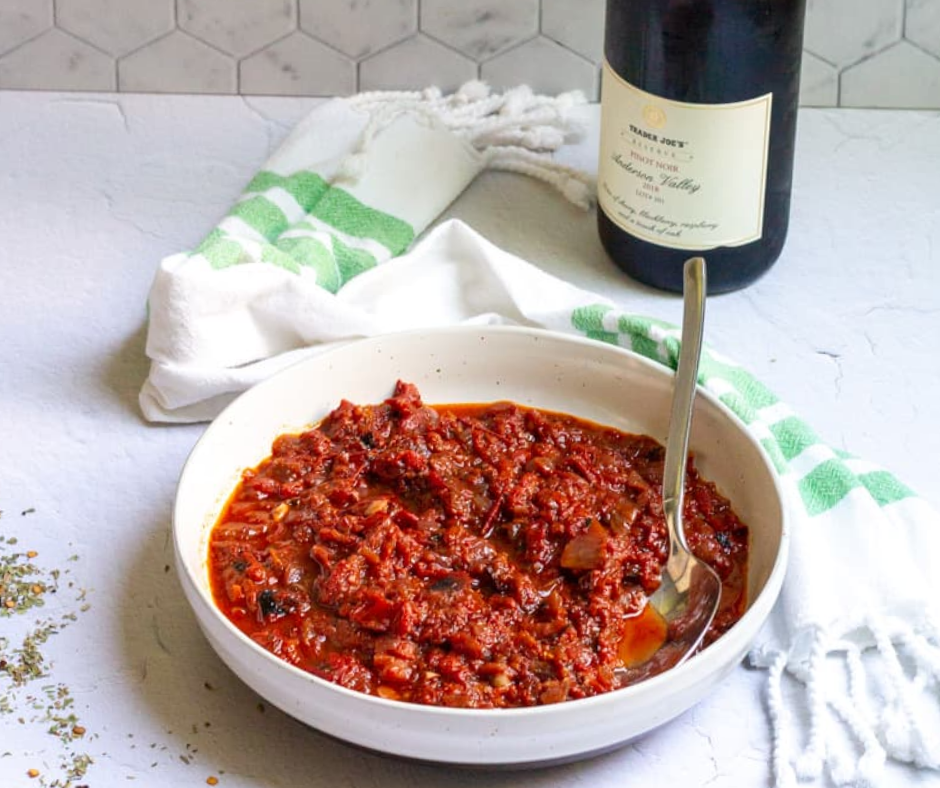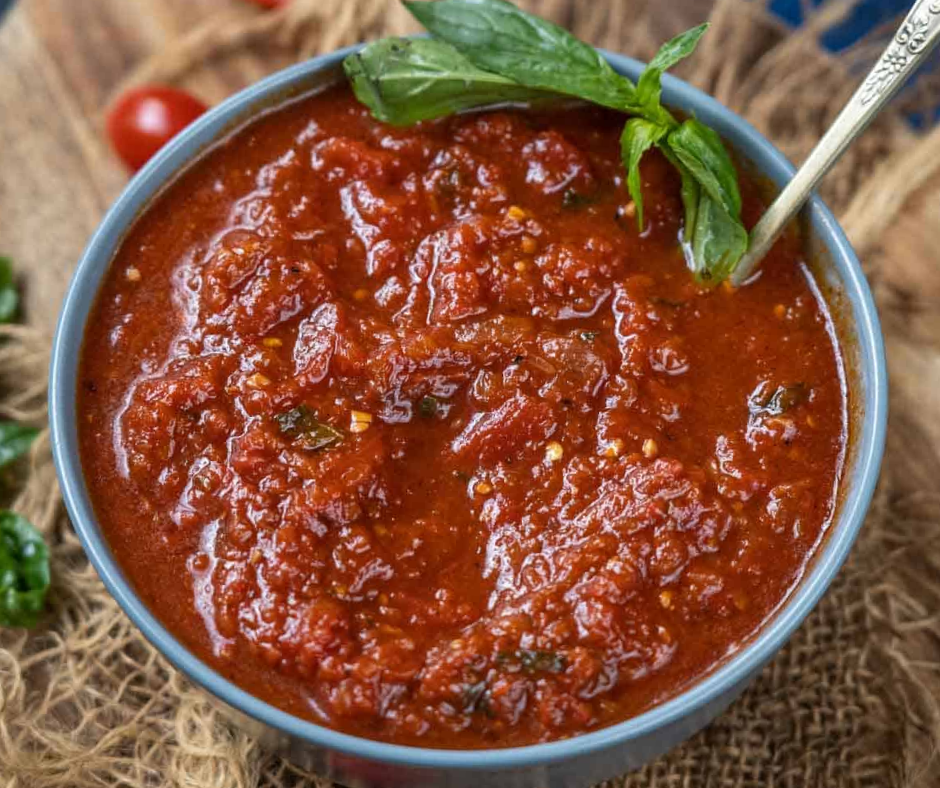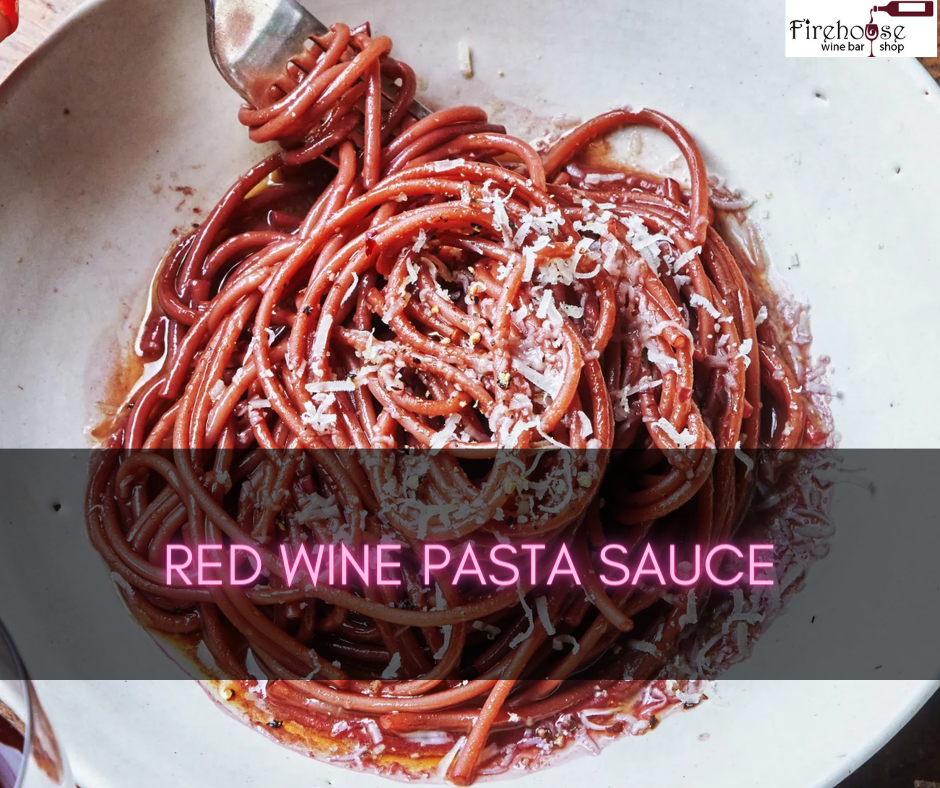Introduction
The Art Of Creating Red Wine Pasta Sauce
Creating a rich and flavorful red wine pasta sauce is an art. It requires a careful blend of ingredients and a perfect balance of flavors. The beauty of this sauce lies in its simplicity and the depth of flavor that the red wine brings to the dish. It is a versatile sauce that can be paired with various types of pasta and enjoyed by both meat lovers and vegetarians alike.
To start, heat some extra virgin olive oil in a large skillet over medium heat. Add grated onion and minced fresh or dried oregano and sauté until the onions are translucent and fragrant. Season with salt and pepper to taste, and then add minced garlic cloves. Stir everything together and let the flavors meld for a few minutes.
Now comes the star of the show – the red wine. Choose a dry red wine such as Cotes du Rhone, Cabernet Sauvignon, or Zinfandel. Pour a generous amount of red wine into the skillet and let it simmer for a few minutes to cook off the alcohol and develop its rich flavors.
Next, add two cans of crushed tomatoes and a drizzle of honey to the skillet. The honey helps to balance out the tomatoes’ acidity and enhances the sauce’s overall sweetness. Let the sauce simmer on low heat for about 20-30 minutes, allowing the flavors to meld together and the sauce to thicken.
Just before serving, add a handful of chopped fresh basil to the sauce and stir it in. The fresh basil adds a wonderful fragrant note to the sauce and complements the flavors beautifully.
Why does Red Wine add Depth To Pasta Sauce?
Red wine is the secret ingredient that takes pasta sauce to another level. It adds depth, richness, and complexity to the sauce, elevating it from ordinary to extraordinary. The flavors of the red wine infuse into the sauce as it simmers, creating a savory and slightly tangy taste that pairs perfectly with the pasta.
The tannins in red wine also help to tenderize the meat and add a subtle bitterness that balances out the sweetness of the tomatoes. Whether you choose a bold and robust red wine or a more delicate and fruity variety, adding red wine brings a whole new dimension of flavor to your pasta sauce.
So, the next time you want to create a showstopping pasta dish, don’t forget to incorporate red wine into your sauce. You’ll be amazed at how it transforms a simple meal into a gourmet experience. Happy cooking!

Basic Ingredients
Selecting The Right Red Wine For Your Sauce
When creating a flavorful and robust red wine pasta sauce, selecting the right red wine is key. The choice of red wine can greatly impact the overall taste and character of the sauce.
It is recommended to use a dry red wine for the best results. A dry red wine, such as Cabernet Sauvignon or Cotes du Rhone, pairs well with the acidity of the tomatoes and adds a rich flavor to the sauce. Zinfandel is also a good option if you prefer a slightly fruitier note in your sauce.
Remember that the quality of red wine does not need to be extravagant, but it should be something you would enjoy drinking on its own. The flavors of the wine will infuse into the sauce as it cooks, so choose a wine that you like the taste of.
Essential Base Ingredients For A Flavorful Sauce
Apart from the red wine, a few essential base ingredients contribute to the overall flavor profile of the red wine pasta sauce.
Heat extra virgin olive oil in a large skillet over medium heat. This provides a rich and luxurious base for the sauce.
Next, add diced onions and sauté them until they become translucent and fragrant. This step adds a savory and aromatic component to the sauce.
To enhance the flavors further, add minced garlic cloves and your choice of dried or fresh oregano. The garlic adds a subtle spicy note, while the oregano hints of earthiness to the sauce.
Finally, the star ingredient – crushed tomatoes. Use two cans of crushed tomatoes to create the base of the sauce. The tangy and sweet flavors of the tomatoes combine with the other ingredients, creating a harmonious balance.
To balance out the acidity of the tomatoes, drizzle in a bit of honey. The honey adds a touch of sweetness, enhancing the overall flavor of the sauce.
Combining these essential ingredients with the richness and depth of the red wine, you’ll create a truly flavorful and irresistible red wine pasta sauce. So gather your ingredients, put on your apron, and get ready to delight your taste buds with this delicious sauce.
Preparing The Sauce
Sauteing Aromatics And Building Flavors
To create a flavorful red wine pasta sauce, start by sautéing the aromatics. In a 5 ½- to 7-quart Dutch oven or heavy-bottomed stock pot over medium heat, heat some olive oil until it’s hot. Add the garlic and onions, and sauté them until they become translucent, releasing their fragrant aroma. This step is crucial as it forms the flavor foundation for the sauce.
Next, it’s time to build on the flavors. Add a pinch of red pepper flakes for a subtle kick and a spoonful of tomato paste for an intense, concentrated tomato flavor. Give these ingredients a quick toss in the olive oil to incorporate them evenly.
Now, for the superstar ingredient: red wine. Pour the red wine into the pan, allowing it to mingle with the other ingredients. Let the mixture simmer for about 10 minutes, allowing the red wine to reduce by half. This reduction process intensifies the flavors of the wine, infusing it with the richness and depth that will elevate the sauce.
Simmering The Sauce To Perfection
Once the red wine has reduced, it’s time to add the remaining components to transform the mixture into a delicious red wine pasta sauce. Start by incorporating diced tomatoes into the Dutch oven or stock pot. If using fresh tomatoes, make sure to chop them into small pieces. If using canned crushed tomatoes, two cans should suffice.
To enhance the flavors even further, it’s time to add herbs. Traditional Italian herbs like basil and oregano work wonderfully in this sauce. Add a handful of whole basil leaves and choose dried or fresh oregano. The basil adds a fresh and fragrant note, while the oregano hints of earthiness to complement the robust red wine.
Allow the sauce to simmer over low heat for 30 minutes to an hour, giving the ingredients enough time to meld together and develop their flavors. Stir the sauce occasionally to prevent it from sticking to the bottom of the pot.
By following these steps and allowing the sauce to simmer to perfection, you’ll create a red wine pasta sauce that is bursting with flavor. The sautéed aromatics, the reduced red wine, and the harmonious blend of herbs and tomatoes will come together in a rich, complex, and simply irresistible sauce. So, get ready to impress your taste buds and elevate your pasta dishes with this flavorful recipe.
Remember, the measurements and additional details can be found in the recipe card below for reference. Enjoy!

Adding The Red Wine
The Key Role Of Red Wine In Pasta Sauce
Red wine is crucial in creating a flavorful and rich pasta sauce. When added to the sauce, the alcohol in the red wine dissolves the fats present, such as olive oil or butter, enhancing their flavors. This process contributes to the overall taste and complexity of the sauce. Red wine adds depth and richness to the sauce, making it more satisfying and enjoyable.
How To Add Red Wine To Your Sauce Effectively?
To effectively incorporate red wine into your pasta sauce, follow these steps:
- Saute the aromatics: Begin by sauteing garlic and onions in a Dutch oven or heavy-bottomed stock pot with olive oil until the onions become translucent. This creates a flavorful foundation for the sauce.
- Build the flavors: Add a pinch of red pepper flakes for subtle heat and a spoonful of tomato paste for intensified flavor. Toss these ingredients in the olive oil to evenly distribute them.
- Pour in the red wine: Add it to the pan, allowing it to combine with the other ingredients. Let the mixture simmer for about 10 minutes to reduce the wine by half, intensifying its flavors.
- Incorporate diced tomatoes: Add diced tomatoes to the pot, whether freshly chopped or canned crushed tomatoes. This adds additional depth and texture to the sauce.
- Add herbs: To enhance the flavors further, include basil and oregano. Basil provides a fresh and fragrant note, while oregano adds an earthy undertone that complements the robust red wine.
- Simmer to perfection: Let the sauce simmer over low heat for 30 minutes to an hour, allowing the ingredients to meld together and develop their flavors. Stir occasionally to prevent sticking.
Following these steps, you can create a red wine pasta sauce bursting with flavor and complexity. Enjoy this sauce’s rich, savory taste paired with your favorite pasta dishes.
Enhancing The Flavor
Incorporating Herbs And Spices For An Extra Kick
Incorporating herbs and spices is essential for adding depth and complexity to the flavors to take your red wine pasta sauce to the next level. The combination of basil and oregano is a classic choice, as they provide a perfect balance of freshness and earthiness that complements the robustness of the red wine.
Fresh basil leaves, either whole or roughly torn, can be added to the sauce during the simmering process. This herb infuses the sauce with a vibrant, aromatic note that elevates the overall taste. If fresh basil is not available, dried basil can also be used, although it is recommended to use a smaller quantity as the flavor can be more concentrated.
Oregano, whether fresh or dried, adds an earthy undertone and a hint of sweetness to the sauce. This herb pairs wonderfully with the red wine, creating a harmonious blend of flavors. Like basil, fresh oregano can be added during the simmering process to release its fragrance and enhance the taste. Dried oregano can also be added earlier in the cooking process to allow its flavors to develop and meld with other ingredients.
Balancing Acidity And Sweetness For A Harmonious Taste
Achieving the perfect balance of acidity and sweetness is crucial in creating a harmonious and well-rounded red wine pasta sauce. The red wine contributes to the sauce’s acidity, while the crushed tomatoes add natural sweetness. However, finding the right balance between the two is important for a truly flavorful sauce.
You can enhance the sauce’s acidity by adding a splash of red wine vinegar or a squeeze of fresh lemon juice to achieve this balance. These ingredients brighten the flavors and add a tangy note that complements the richness of the red wine. Be sure to taste the sauce as you go along and adjust the acidity according to your preference.
On the other hand, if you find the sauce too acidic, you can counterbalance it by adding a pinch of sugar. This helps round out the flavors and bring a sweetness to the sauce. Start with a small amount and gradually add more if needed, tasting as you go to ensure the sauce is perfectly balanced.
By incorporating these techniques of adding herbs and spices for an extra kick and balancing acidity and sweetness, you can create a red wine pasta sauce that is bursting with flavor and complexity. Whether you’re serving it with spaghetti, rigatoni, or penne, this sauce will surely elevate your pasta dishes to a new level of deliciousness.

Perfect Pairings
Choosing The Right Pasta For Red Wine Sauce
Choosing the right pasta shape is key when pairing pasta with red wine sauce. The sauce should cling to the pasta, enhancing every bite with its rich flavors. Spaghetti and penne are excellent choices as they provide ample surface area for the sauce to adhere to.
The long strands of spaghetti create a perfect balance between sauce and pasta, allowing each bite to be coated with the savory goodness of the red wine sauce. Penne, with its ridges and hollow center, traps the sauce, creating pockets of flavor in every mouthful. Regardless of the pasta shape, cook it al dente to retain its texture and firmness, providing a satisfying bite.
Delicious Toppings And Proteins To Complement The Sauce
While the red wine sauce is already bursting with flavor, adding toppings and proteins can take it to another level. Freshly grated Parmesan cheese sprinkled over the pasta adds a creamy, nutty note that complements the sauce’s richness. For an extra touch of freshness, garnish the pasta with chopped basil leaves or a drizzle of extra virgin olive oil. If you want to add some protein to your meal, grilled chicken or shrimp pairs wonderfully with the robust flavors of the red wine sauce. The tender and succulent meat adds a hearty element to the dish, making it a satisfying and complete meal.
Choosing the right pasta shape and adding delicious toppings or proteins can create a well-rounded and flavorful dish that perfectly complements the red wine sauce. Whether you prefer classic spaghetti with Parmesan and basil or want to elevate your meal with grilled chicken or shrimp, these pairings will enhance the taste and experience of your red wine pasta sauce. So grab a glass of red wine, prepare this flavorful recipe, and indulge in a delightful and satisfying meal. Happy cooking!
Tips And Tricks
Pro Tips For Achieving The Best Results
Creating a flavorful red wine pasta sauce requires some extra attention and technique. Here are some pro tips to help you achieve the best results:
- Sweat your onions and garlic: When sautéing them, sweat them over medium heat until they are soft and translucent. Avoid browning them, as this can give the sauce a bitter taste.
- Choose the right wine: Select a dry red wine with a medium body and moderate tannins for the sauce. A Chianti or a Merlot is a good choice, as they provide a balanced flavor and acidity.
- Allow the sauce to reduce: For a thicker sauce, remove the lid from the pot during the last hour of cooking. This will allow the sauce to reduce and intensify the flavors.
- Adjust the acidity: If your sauce tastes too acidic, add one tablespoon of granulated sugar to counterbalance the acidity. This will help balance the flavors and make the sauce more enjoyable.
Storing And Reheating Your Red Wine Pasta Sauce
If you have made a large batch of red wine pasta sauce and want to store it for later use, follow these tips:
- Cool the sauce: Allow the sauce to cool completely before storing it. This will prevent the build-up of condensation and potential spoilage.
- Store in airtight containers: Transfer the sauce to containers or zip-lock bags. Make sure to remove any excess air to prolong the sauce’s freshness.
- Freeze or refrigerate: You can freeze the sauce for up to 3 months or refrigerate it for up to 4 days. Remember to label the containers with the date for easy reference.
- Reheating the sauce: When reheating the sauce, thaw it overnight in the refrigerator if frozen. Heat it gently over low heat on the stovetop, stirring occasionally, until heated through. Alternatively, you can microwave it briefly, stirring until hot.
Following these tips will ensure that your red wine pasta sauce retains its flavors and quality even after storing and reheating. So go ahead and make a big batch of this delicious sauce, store it for later use, and enjoy a hassle-free meal whenever you crave a taste of Italy.
Variations And Substitutions
Exploring Different Types Of Red Wine For Unique Flavors
One of the great things about making red wine pasta sauce is the opportunity to experiment with different types of red wine to create unique flavors. While the recipe calls for a reasonably priced Cabernet Sauvignon, you can try using other red wines to add your twist to the sauce. Here are a few options to consider:
- Merlot: This medium-bodied red wine has a smooth, fruity flavor that pairs well with tomatoes. It can add a touch of elegance and depth to your sauce.
- Chianti: Chianti is a red wine from Tuscany, Italy, known for its bright acidity and cherry flavors. Using Chianti in your sauce can give it a vibrant and tangy taste.
- Shiraz or Syrah: If you prefer a bolder and spicier sauce, try using Shiraz or Syrah. These wines have rich flavors of blackberry, pepper, and smoky notes that can add a robust character to your sauce.
- Pinot Noir: For a lighter and more delicate sauce, consider using Pinot Noir. This red wine has flavors of red berries and earthy undertones, creating a subtle and nuanced sauce.
Adapting The Recipe For Dietary Restrictions Or Preferences
If you have dietary restrictions or preferences, you can easily adapt this red wine pasta sauce recipe to suit your needs. Here are some options:
- Vegetarian or Vegan: Omit the ground meat and use vegetable broth instead of beef broth to make the sauce vegetarian or vegan-friendly. You can also add mushrooms or other vegetables for added flavor and texture.
- Gluten-Free: Ensure that the canned tomatoes, tomato paste, and other ingredients you use are gluten-free. You can substitute regular pasta with gluten-free pasta to make the dish completely gluten-free.
- Low-Sodium: If you watch your sodium intake, use low-sodium broth and canned tomatoes. You can also reduce the amount of added salt and increase the use of herbs and spices to enhance the flavors.
- Spicy Variation: Add some red pepper flakes or diced jalapeños to the sauce if you enjoy a little heat. Adjust the amount to your preference for a spicy kick.
By exploring different types of red wine and adapting the recipe to meet your dietary restrictions or preferences, you can truly make this red wine pasta sauce your own. So get creative in the kitchen and enjoy a delicious, personalized pasta dish!
Conclusion
In conclusion, creating red wine pasta sauce can elevate your pasta dishes to a new level. The richness and depth of flavor the red wine brings to the sauce is remarkable. With just a few simple ingredients and creativity, you can whip up a flavorful red wine pasta sauce to impress your family and guests.
Enjoying The Richness Of Red Wine Pasta Sauce
One of the greatest pleasures of making red wine pasta sauce is savoring its rich and savory flavors. Combining red wine, tomatoes, and aromatic herbs creates a bold and tangy sauce. Whether you choose a smooth Cabernet Sauvignon, a fruity Merlot, a vibrant Chianti, a bold Shiraz or Syrah, or a delicate Pinot Noir, each wine adds a unique character to the sauce. This versatility allows you to customize the flavors to your liking.
Putting Your Twist On This Classic Recipe
While the basic recipe for red wine pasta sauce is delightful, don’t be afraid to put your twist on it. Experiment with different types of red wine to create unique flavors. You can adapt the recipe to suit your dietary restrictions or preferences by omitting or substituting certain ingredients. Whether you’re a vegetarian or vegan, following a gluten-free diet, watching your sodium intake, or looking to add a little heat, there are endless possibilities to customize this sauce to suit your needs.
By exploring different types of red wine and adapting the recipe to meet your dietary restrictions or preferences, you can truly make this red wine pasta sauce your own. So get creative in the kitchen, gather your favorite ingredients, and enjoy a delicious and personalized pasta dish. The possibilities are endless, resulting in a satisfying and flavorful meal.
Red Wine Pasta Sauce: A Flavorful Recipe
If you’re in the mood for a bold and elegant dinner, look no further than this homemade red wine pasta sauce. With its savory and slightly tangy flavor, it’s sure to impress your taste buds. This recipe is easy to make and requires just a few simple ingredients.
Heat 2 tablespoons of extra virgin olive oil in a large skillet over medium heat. Saute the grated onion, minced fresh oregano (or dried oregano if you prefer), and a pinch of salt and pepper. Add in some minced garlic cloves to add an extra layer of flavor.
Next, it’s time to add the star ingredient – the dry red wine. Choose a wine such as Cotes du Rhone, Cabernet Sauvignon, or Zinfandel. Pour the wine into the skillet, allow it to simmer, and reduce by half for about 3-5 minutes.
Now it’s time to add the crushed tomatoes to the skillet. Stir everything together and let the sauce simmer for about 15-20 minutes, allowing the flavors to meld together and the sauce to thicken slightly. For sweetness, you can adjust the seasoning with salt, pepper, and honey.
Once the sauce is ready, you can serve it over your favorite pasta, spaghetti, or penne. If you want a healthier option, toss it with zucchini noodles for a veggie-packed dish.
This red wine pasta sauce is versatile and can be reduced further to create a rich marinara sauce for pizza or other dishes. Its deep flavors and rich texture make it a favorite among pasta lovers.
So why not impress your family and friends with this flavorful red wine pasta sauce? It’s the perfect recipe to add a touch of elegance to your next dinner. Happy cooking!
FAQ
Q: What type of red wine should I use for this red wine pasta sauce recipe?
A: You can use dry red wine such as Cotes du Rhone, Cabernet Sauvignon, or Zinfandel.
Q: How many cans of crushed tomatoes should I use?
A: You need two 28-ounce cans of crushed tomatoes for this recipe.
Q: Can I replace the whole-wheat pasta with another type of pasta?
A: Yes, you can replace it with any pasta you prefer.
Q: Can I use dried basil instead of fresh basil?
A: Yes, you can use one teaspoon of dried basil instead of fresh basil.
Q: How long does it take to reduce the red wine?
A: It takes about 3-5 minutes to reduce the red wine by half.
Q: Can I use this red wine pasta sauce as a marinara sauce on pizza?
A: Yes, you can reduce down a couple of cups and use it as a marinara sauce on pizza.
Q: How many cups of pasta does this recipe serve?
A: This recipe makes 7 cups of sauce, which is enough for 2 pounds of pasta.

Andre Lotz immigrated to the United States from South Africa almost 20 years ago. Still, he didn’t feel truly at home until he settled in Mobile—a city that reminds him of his childhood home of Fish Hoek on the southern cape of Africa.

